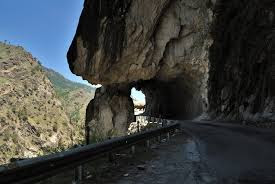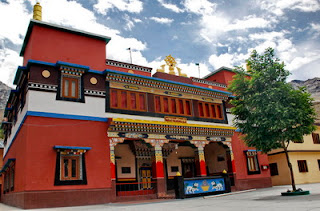Place to Visit in Kinnaur.
The area of Kinnaur region due to huge difference in its height,
weather and scenery represents diverse fauna and flaura. For the reasons for
their environmental, faunal, flowery and geomophilogical significance three untamed
life sanctuary are set up in the region. The min objective of these are to put
aside the uncommon class. diverse variety of wildlife can be seen in these sanctuary.
Kalpa is located at an height of 2759 m from the sea height,
on the old Hindustan Tibet Road at a distance of 260 km from Shimla. previous
it was the District Headquarter of Kinnaur. It is 14 kms. and semi an hour's force
from District Headquarter Reckong Peo. It has all the individuality of a inheritance
township. Kalpa came into fame in the wake of British Governor General Lord
Dalhousie's stay in th 19th century. The Narayan-Nagani temple is an very good
of restricted craftmanship. There are pair of Buddhist monasteries at Kalpa counting
the Hu-Bu-Ian-Car Gompa, said to be founded it by Rinchensang-Po
(950-1055AD).Kalpa is radically situated close to the base of 6050 meter high
Kinner Kailash. This is the famous winter home of Shiva. This is a stunning view
near the beginning in the morning as the increasing sun touch the snowy peaks
with pink and gold light.
Reckong Peo.

Reckong Peo is located at an height of 2670 m from the ocean
height, situated 235 km from Shimla. It is the region Headquarter having a
panoramic sight of Kinner Kailash. Kinner Kailash mountain is regard as one of
the legendary homes of Lord Shiva, here is a 79 feet far above the ground rock configuration
that resemble Sivalinga. This Sivalinga changes the colour as the day passes.
Also able to be seen on the make bigger is the climax of Raldang (5499 m).
Reckong Peo has many hotels and relax houses. There is a Buddhist Monasteries
in the Reckong Peo.
Sangla, a crowded township, located on the correct bank of
the Baspa river, is well-known for its far above the ground lush earth, at an height
of 2621 m on top of the sea height and waterfall at a distance of 17 km from
Karcham. It is built on a grade with the house increasing one on top of the additional;
the sight life form stopped up by the enormous Raldang peaks very tall at the
back. The forest landscape all-arround and the everlasting snow peaks are charming.
Trip from Karcham beyond is pleasant and daring all through the valley. The usual
landscape all arround and the everlasting snow view are pictorial and delightful.
It is situated in the well-known Baspa valley. The entire of the Baspa valley
is one of the prettiest valleys mostly owing to its level land and green
vegetation on the slopes which are not very steep.
Chango (3058m) : At a coldness of 122 km from Kalpa, is a compilation
of 4 hamlets in Pargna Shuwa, sub-tehsil Hangrang on the left bank of the river
Spiti. It is surrounded on each surface by far above the ground hills which is observer
to the attendance of a previous lake. Buddhism is usually skillful here but
there are a number of local Hindu deity too that is Gyalbo, Dablaand Yulsa.
Chhitkul.

Chhitkul(3450m):This is the previous and uppermost town in
the Baspa valley. It is located on the right bank of the Baspa river. There is
a street the length of the left bank from Karchham. There are three temples of restricted
goddess Mathi, the most important one said to have been construct concerning
500 years ago by a occupant of Garhwal. The four-sided figure ark of the
goddess, is made of walnut wood and is enclosed with clothes and surmount by a clump
of yak tail. Two pole called bayanga are insert into it by income of which it
is approved. The goddess has a mouthpiece.
Kothi .
Kothi is too called Koshtampi is an very old big town in
tehsil Kalpa, small underneath the Kalpa and near Reckong Peo. The town is
environed by the fields and fruit trees punctuate by vineyard. It is in excess
of shadow by Kinner Kailash peak which forms a magnificent backdrops. The town
with its good-looking temple, tanks and gracious willows makes an in total beautiful
scenery. The goddess Shuwang Chandika temple is in the town. The restricted citizens
grasp the goddess in huge respect and think her to be one of the mainly influential
goddess.There is an picture of gold seated in an ark. It is dance up and downward
by four people at the time of worship.There is yet one more temple dedicated to
Bhairon.
Concerning 105 kms from Reckong Peo pearched on little stony
distinction, on the right bank of Spiti river, and at the flowing together of
the Lipak violent flow graceful from the west is the hqrs. of sub-tehsil
Hangrang in pooh sub-division.At the east of it is an insulate rock once surmount
by a fortification, now in shell substantial It occupy a trip of earth
embosomed by germ-free ample of the earth bright beneath the ardour of a hot
sun. From such a state of affairs the weather has acquire a tasty smoothness.
Lippa.
Lippa(2438m): located close to the left bank of Taiti watercourse.
The lawn of this town is supposed to be establish to be extremely nutritious to
livestock and horses. Ibex are supposed to be establish in the near forest.
There is a game sanctuary. There are three Buddhist temples dedicated to
Galdang Chhoikar, Dunguir and Kangyur. separately from the Buddhist temples
there is yet one more old refuge devoted to Tangtashu, a local deity.
Moorang.

Moorang(3591m): located on top of the absent bank of Satluj
at a few space from the flowing together of the Tirang and 39 kms absent from
the Kalpa. The place is very attractive and move toward to this pictorial town
is from side to side apricot orchard. The dell is surrounded by the haughty
mountains on each area, apart from westward open to the Satluj, on the store of
which there is an aged fort supposed to be built by Pandavas. The fort has a four-sided
figure arrangement located on a hill overlooking the Satluj. Its most important
gate is easy to talk to by a separate steps. It has a level roof. The restricted
divinity is Urming and there are three structure devoted to the god each obtainable
in Thwaring, Garmang and Shilling. Usually these are unfilled as the ark of the
god leftovers in the fort. On a holy day the ark is taken to the on top of
named places. The ark has got 18 'mukh', complete of silver, gold and brass.
The 18 mukh represents the 18 days of the huge marathon Mahabharat.
Nichar.

Nichar(3150m) : This town is located between Taranda and
Wangtu on the absent bank of Satluj concerning 5 kms on top of Wangtu.The landscape
is charming and the weather is renowned for its gentleness. In the broad
forests and stony glen from this place descending goral and thar antelopes be
plentiful in. Black and red bears are too seen in the senior and colder
portions of the variety. The town god is goddess Ukha.

Nako(3663m): located on
top of 3 kms over the Hangrang valley road and is 119 kms from Kalpa on the
western way of the huge mountain of Pargial. This is the uppermost town in the
valley andexistence of lake shaped out of the ample of the ice and
snow on top of adds loveliness to the village.The lake is fringed with willows
and populars. Yaks, kine, livestock and asses are reared here in profusion. restricted
town god is Deodum and one more Lagang temple with more than a few idols live
here.There is a staying shed for visitors.There are little, but important
Buddhist temples and a astound is regard to have the track of the saint Padmasambhava.
This is the bottom for the hike to pargial climax and is en-way to the
Thashigang monastery, where an picture is said to produce hair.
Namgya.
Namgya(3048m): Namgya
is located on the absent bank of the Satluj river about two kms on top of the flowing
together of the Spiti river with the Satluj. It is on top of 183m and 313m over
the bed of the Saltuj river. It is bounded by appalling infertility and unhappiness,
still close to the habitat on the conflicting bank of a stream can be seen
field of barley, buckweat, turnips and a few vines and apricots.There is a
Buddhist temple named Lagang and four local goddess namely Chola, Bushahru,
Dabla and Kuldeo Narain. Each of them has a separate labdak (mouthpiece).
Pooh.

pooh is nearby marked Spuwa and is tehsil hqrs. It is 71 kms
from Reckong Peo. It is located on top of the nationwide highway-22 having all current
facilities as well as green fields, vineyards, apricots, almond and grape
orchards improve its attractiveness. The restricted god is called Dabla, who
neither has any house nor possesses an ark. The only sign of the divinity is a extremity
with a little icon set on its higher piece and decorated with yak tail hair and
long pieces of coloured cloth. The entire being called Fobrang, it is time bring
to the Santhang.
Rakchham

Rakchham(3115m):
Rakchham is located on the correct bank of the river Baspa. Its name is resulting
from "Rak" a stone and "Cham" a bridge. It is said that in
the previous time there was a normal stone bridge over the Baspa river therefore
the name of the village.The site of the town is arresting at the western
exremity of a glen, and at the bottom a enormous mass of bare rock, which rises
suddenly in numerous black spires above the town.
Ribba.
Ribba(3745m): Ribba or Rirang is one more big crowded town
at a space of 14 kms from Moorang, the tehsil hqrs. situated flanked by the village
of Purbani and Rispa. In the restricted vernacular ri stands for Chilgoza and
rang profits a peak of mountain.This city is situated on the northern surface
of the lofty Kinner Kailash group. Its environs are filled of the trees of not
poisonous pine.This as well as one more town Rispa are recognized for their
grapes orchards and the alcohol well-known grape distilled from the vineyards
of Ribba.


































































